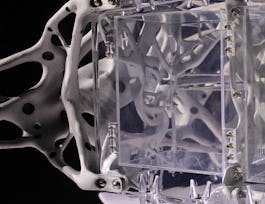With design for manufacturing, our design process focused on the design over its cost, but always keeping in mind how parts needed to be made. With manufacturing at the core of a design, we're able to fix potential problems in the design phase rather than after production. In many cases, the end product is made up of an assembly of different pieces to simplify manufacturing or to achieve specific design goals. Each piece represents a certain tolerance and put together, things might not work or fit if they weren’t accounted for in the design.


CAM and Design Manufacturing for Mechanical Engineers with Autodesk Fusion 360
This course is part of Autodesk CAD/CAM/CAE for Mechanical Engineering Specialization
Taught in English
Some content may not be translated

Instructor: Autodesk
19,902 already enrolled
Included with 
Course
(581 reviews)
99%
What you'll learn
Inspect a multicomponent assembly.
Identify manufacturing methods based on part inspection.
Create detailed drawings for manufacturing.
Practice creating toolpaths for manufacture.
Skills you'll gain
Details to know

Add to your LinkedIn profile
2 quizzes
Course
(581 reviews)
99%
See how employees at top companies are mastering in-demand skills

Build your subject-matter expertise
- Learn new concepts from industry experts
- Gain a foundational understanding of a subject or tool
- Develop job-relevant skills with hands-on projects
- Earn a shareable career certificate


Earn a career certificate
Add this credential to your LinkedIn profile, resume, or CV
Share it on social media and in your performance review

There are 4 modules in this course
In Week 1, we’ll focus on the creation of detailed drawings for production. Understanding not only how to create or customize a drawing, but also how to identify critical features or aspects of a design on a drawing is key to helping ensure the parts you get are the parts you want.
What's included
14 videos6 readings1 quiz2 discussion prompts
In Week 2, we’ll discuss topics surrounding the review and modification of designs for manufacture. From tool accessibility, to understanding the required tools and the design of fixturing and soft jaws for vises, this week will help prepare for programming toolpaths. We explore and understand the cost associated with part setup, raw stock, and material removal to better identify design changes for production.
What's included
7 videos3 readings1 discussion prompt
In Week 3, we’ll focus on setting up and creating a CNC milling program. We’ll lay the foundation for all programs by creating and managing a tool library, defining a setup, and creating milling and drilling toolpaths. The setup and creation of these will be the basis for nearly every milling program.
What's included
12 videos3 readings1 discussion prompt
In Week 4, we’ll cover additional toolpaths required to help rough and finish complex 3D shapes. Understanding the toolpaths available and the types of geometry they can be used on will help you to make informed decisions on any part. Toolpaths often have strengths and weaknesses based on the geometry and we'll identify some of these to help get your parts to the shop floor quicker.
What's included
14 videos4 readings1 quiz1 peer review1 discussion prompt
Recommended if you're interested in Mechanical Engineering

Coursera Project Network

Coursera Project Network

Coursera Project Network
Why people choose Coursera for their career




Learner reviews
Showing 3 of 581
581 reviews
- 5 stars
85.73%
- 4 stars
13.23%
- 3 stars
0.68%
- 2 stars
0.17%
- 1 star
0.17%

Open new doors with Coursera Plus
Unlimited access to 7,000+ world-class courses, hands-on projects, and job-ready certificate programs - all included in your subscription
Advance your career with an online degree
Earn a degree from world-class universities - 100% online
Join over 3,400 global companies that choose Coursera for Business
Upskill your employees to excel in the digital economy
Frequently asked questions
Yes! Autodesk also has Learning Pathways to start you on your learning journey, including certification prep courses and practice tests—so you feel confident when you take an Autodesk certification exam.
Visit this page to learn how to download Fusion 360 and to learn about the Autodesk Education license terms.
Professionals can purchase an annual or monthly commercial subscription to Fusion 360. For more information, visit the Fusion 360 subscribe page.
Fusion 360 is also available for free to all users as a 30-day trial.


